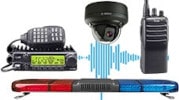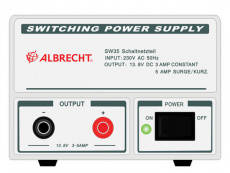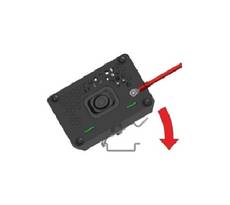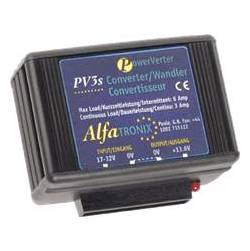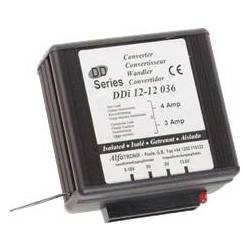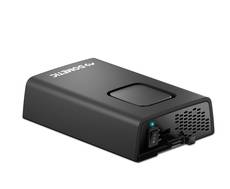- Special Offers
- Transceiver Radio
- Transceiver Accessory
- Antennas
- Antenna Accessory
- Cable
- Connector
- Installation Material
- Installation Tools
- Measuring Equipement
- Body Worn Camera
- Electrosmog
- Telephone
- Baby Monitor
- Fever Thermometer
- Radio Device
- Set-top Boxes
- Personal Protective Equipment
- Motorcycle Helmet Speaker
- Car Equipment
- Voltage Converter
- Desktop Power Supply
- AC/DC Voltage Converters
- DC/DC Converter
- Voltage Stabiliser
- DC/AC Inverters
- Dry Cell
- Battery
- Battery Charger
- Emergency Signal
- Amber Signal
- Sound Signal
- Light and Sound Signal Accessory
- Traffic Engineering
- LED Lamp
- Smart Home
- Mosquito Repellent Device
- Market - Other Products
- Discontinued Products
Voltage Converter
- further categoriesA distinction is made between inductive and capacitive voltage transformers. In Europe we mainly use inductive voltage transformers. Inductive type versions operate in a similar way to single-phase transformers, with two or three windings. Capacitive voltage transformers are most often used for high voltage applications.
Voltage converters can be used, for example, to power electronics that are shipped from overseas or other electronic devices with special voltage requirements. Whether you're looking for a DC/DC or AC/DC converter, a DC/AC inverter or a stabilizer, you'll find them all in the DND webshop range.
These voltage converters deliver the performance they promise, so you can always use your electronics as intended and safely. Let's take a look at the details of what voltage converters are available in the DND webshop range.
What you need to know about DC/DC voltage converters
A DC/DC converter can be used to provide a supply voltage lower or higher than the battery voltage. There are both step-down and step-up converters. The input voltage of step-down converters is higher than the output voltage. In step-up converters, the reverse is true, i.e. the output voltage is higher than the input voltage.
When buying these types of converters, make sure to check which product family the DC/DC converter belongs to. In addition, it is worth checking the figures on the voltage converter for the input voltage range, output power and output current.
But it is also worth checking whether the device can be mounted on a mounting plate, for example. But also important information is the enclosure, the number of outputs and the weight of the converter.
Why do we need AC/DC converters?
AC/DC voltage converters, or as they are called by professionals converters, power adapters convert alternating current (AC) input to direct current (DC) output. This is because our homes, offices and industrial facilities receive 100 V or 200 V AC voltage.
Most of the electrical appliances we use, however, operate on 5 V or 3.3 V DC. This means that the appliances cannot work without converting the AC voltage to DC.
This is how our electronic devices become usable. And if the device also has a battery, the converter can also be seen as a charger, which can be useful for many electronic devices in everyday life. The voltage is usually reduced by the transformer to suit the needs of the connected device.
When to use DC/AC converters?
DC/AC voltage converters, or inverters, convert direct current (DC) into alternating current (AC). They are an excellent choice in any location where no mains power source is available. Thanks to these converters, also known as inverters, you can watch TV or use large electronic devices in your car, boat or caravan.
The direct current from your car battery is converted into alternating current and you can use these devices by plugging them into a cigarette lighter. This is because the use of alternating current is necessary to operate large electronic devices. The car voltage converter provides stable voltage, frequency and high quality sine wave operation.
The car inverter, which can be plugged into a vehicle's cigarette lighter or directly into its battery, can convert DC 12V to 230V AC mains voltage, so it can now power a variety of home appliances, consumer electronics such as mobile phone chargers, laptops, portable televisions. For safe operation, this type of voltage converter is equipped with overcurrent and thermal protection.
When using a voltage converter, what type of connector should be used?
You can choose a power adapter that differs in the type of connector or the voltage rating. But before travelling, it's also worth choosing our travel adapter so we can use our essential mobile phone or laptop. Especially if you're going to a country where you'll need it.
Which countries? We're thinking mainly of the US, the UK, Australia and China. But if you're going on a trip or a long car or boat trip, make sure you have a cigarette lighter socket with you.
For other equipment and appliances bought in America or Asia, you'll need a voltage converter plug. Because we need to convert 230V to 110V to enjoy our electrical devices at home without any problems.
In which cases is a voltage converter essential?
If you want to use a device that has a different voltage requirement than the one in your geographical area, or if you don't have access to mains power, or if you want to use your phone charger or laptop, you will need a voltage converter.
For example, if you get a synthesizer from North America that uses 110/125 volts AC, you will need to buy a converter to use it. This applies to all other electronic devices that do not follow the 230 V voltage standard used in Europe and Hungary.
What is the difference between direct current and alternating current?
The difference between direct current (DC) and alternating current (AC) is the direction in which the electrons flow. In DC, the electrons flow in a uniform, single direction, "forward". With AC, however, the electrons are constantly changing direction, for example, going forwards and then backwards. In DC, the current between the two poles flows in one direction, and in AC, the directions are alternating.
What to look out for before choosing and using a voltage converter?
We could call it step zero, but first you need to check the voltage and current requirements of the device you want to operate. Once you've established whether an AC/DC converter or DC/DC converter, or other voltage converter, is the answer, it's best to choose only from reputable, proven brands.
On the DND webshop you can choose from a range of voltage converters from trusted manufacturers. Take a look at our range!

